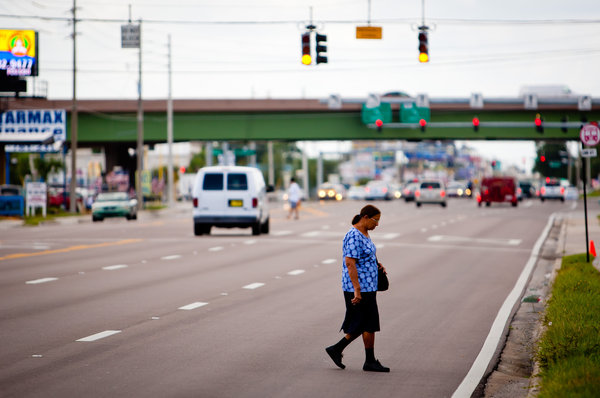A recent report by the Centers for Disease Control found that while 10.5 percent of all trips in the United States are made on foot, pedestrians made up 13 percent of all traffic fatalities between 2001 and 2010. During those years, a staggering 47,392 pedestrians were killed on American roadways. In 2010, the per capita pedestrian fatality rate in America was more than double the rate in the UK and Germany -- 13.9 deaths per million people compared to 6.7 and 5.8, respectively, according to figures compiled by the British government [XLS].

The CDC report also highlights the social dimensions of this public health epidemic. Not everyone is affected equally by dangerous walking conditions in America. Elderly and minority populations are at the greatest risk, researchers found, while men of all demographics were two-and-a-half times more likely than women to be killed by a car while walking.
Men over age 85 and women between the ages of 75 and 84 suffer a disproportionate share of pedestrian deaths. These high-risk age cohorts were each more than three times as likely to be killed while walking than people between 15 and 24 years of age. As a result, CDC officials predict overall pedestrian fatality rates may increase in the coming years as the American population ages.
Pedestrian fatalities also took a high toll on Native American, Hispanic, and black populations. Native American men were four times more likely than white men to be killed while walking, and the fatality rates for black and Hispanic men are about twice that of white men. The disparity was less pronounced for women, but even so, Native American women are roughly twice as likely as white women to be the victim of a fatal pedestrian crash, while Hispanic and black women are 50 percent more likely.
The discrepancy may be partly explained by the fact that more people of color tend to live in urban areas, where residents walk more and are more exposed to traffic violence as pedestrians. (The lower level of driving in cities means that urban residents are less exposed to traffic violence overall.) Another factor is that black and Hispanic families are much less likely to own a car than white families, so these populations also walk more than the public overall.
From a policy perspective, one implication is that any initiative that increases risk to pedestrians -- increasing speed limits, for example -- is likely to have inequitable consequences across society.





